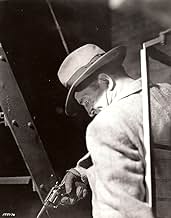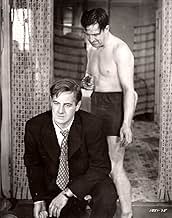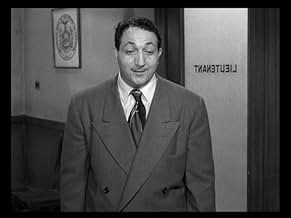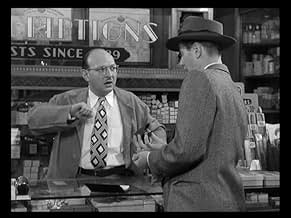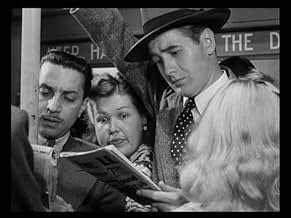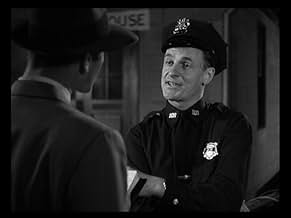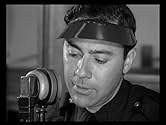IMDb RATING
7.5/10
16K
YOUR RATING
A step-by-step look at a murder investigation on the streets of New York.A step-by-step look at a murder investigation on the streets of New York.A step-by-step look at a murder investigation on the streets of New York.
- Won 2 Oscars
- 6 wins & 5 nominations total
Ted de Corsia
- Willy Garzah
- (as Ted De Corsia)
Mark Hellinger
- Narrator
- (voice)
Jean Adair
- Little Old Lady
- (uncredited)
Celia Adler
- Dress Shop Proprietress
- (uncredited)
Janie Alexander
- Girl
- (uncredited)
Joyce Allen
- Shopgirl
- (uncredited)
Beverly Bayne
- Mrs. Stoneman
- (uncredited)
Featured reviews
There were quite a few reasons for wanting to see 'The Naked City'. Like Barry Fitzgerald in a lot of other films ('And Then There Were None' being my introduction to him and still consider his performance in that one of his best), though it was interesting to see him in a lead role rather than his relative usual supporting roles and an atypical one at that. Really like what has been seen so far of Jules Dassin's work, especially 'Night and the City'. Also wanted to see whether the film lived up to its highly influential reputation.
Good news is mostly 'The Naked City' does. One can see why 'The Naked City' was influential in its documentary style, which at the time and even by today's standards innovative, and how it is treated in a way that is driven by its characters and with an emphasis on the police and how they worked. And that makes it a highly interesting film and elevates that is fairly conventional, with familiar genre tropes, in the story department. Yet still makes a gripping film regardless of that.
Not many problems here, though for my tastes Don Taylor seemed bland and detached, not always looking very comfortable either.
Do think that the narration could have been used less, as some of it did not always feel needed.
Conversely, 'The Naked City' is immaculately photographed and New York, like its own character, is a major star here. The cinematography and editing Oscars were richly deserved. The haunting score adds hugely, as does Dassin's direction. Dassin is highly successful in creating an authentic, audacious and sometimes unsettling visual style. He is equally successful at keeping the story at a controlled, yet never in my mind mannered or tedious, way that sustains the suspense brilliantly.
Loved the layered tautness of the script outside of the narration, while the story is gripping and its intelligence, high suspense and a knockout of a final chase made me able to forgive that it was quite conventional. The opening sequence is a unique one. Outside of Taylor, didn't actually have an issue with the performances. Although an effective Fitzgerald has been widely talked about, on both sides of good and not so good (am in the former camp), for me the best performance came from chilling Ted De Corsia.
In conclusion, very good film and deservedly influential. 8/10
Good news is mostly 'The Naked City' does. One can see why 'The Naked City' was influential in its documentary style, which at the time and even by today's standards innovative, and how it is treated in a way that is driven by its characters and with an emphasis on the police and how they worked. And that makes it a highly interesting film and elevates that is fairly conventional, with familiar genre tropes, in the story department. Yet still makes a gripping film regardless of that.
Not many problems here, though for my tastes Don Taylor seemed bland and detached, not always looking very comfortable either.
Do think that the narration could have been used less, as some of it did not always feel needed.
Conversely, 'The Naked City' is immaculately photographed and New York, like its own character, is a major star here. The cinematography and editing Oscars were richly deserved. The haunting score adds hugely, as does Dassin's direction. Dassin is highly successful in creating an authentic, audacious and sometimes unsettling visual style. He is equally successful at keeping the story at a controlled, yet never in my mind mannered or tedious, way that sustains the suspense brilliantly.
Loved the layered tautness of the script outside of the narration, while the story is gripping and its intelligence, high suspense and a knockout of a final chase made me able to forgive that it was quite conventional. The opening sequence is a unique one. Outside of Taylor, didn't actually have an issue with the performances. Although an effective Fitzgerald has been widely talked about, on both sides of good and not so good (am in the former camp), for me the best performance came from chilling Ted De Corsia.
In conclusion, very good film and deservedly influential. 8/10
This is a great Film Noir movie which I enjoyed very much. My favorite part is watching all the 100's of people on the streets on New York City not having a clue that the are immortalized in this motion picture. I love to freeze frame the street scenes and view how life was like in 1948. So many surprises, for example in the phone booth scene, notice the two men peering out the window in the store across the street. I think those guys were aware of the filming, but as the scene continued, they went back to serving their customers. Just plain magic. There is also a cool goof in this film. Note during the train station chase scene, just after Frank runs by, the director or a film crew member turns towards the camera and yells what I believe is "CUT"...So Fun....I'll see again and again and again!
Can film noir work in broad daylight - surely a contradiction in terms..? Well, here, it's attempted and largely pulled off by director Jules Dassin with a down-to-earth almost documentary realism which fully involves the viewer in the action as the well-known tag-line "1 of 8,000,000 stories" (the murder of a pretty female immigrant who's fallen into bad company and criminal habits) is played out over a three-day period in a sunny summery New York cityscape. William Daniels' excellent photography captures a city constantly on the move with its own citizens as accidental extras and actual locations as would-be film-sets. Just as effective is the natural vernacular dialogue with some great one-liners thrown in - none better than Barry Fitzgerald seemingly admiring the rear view of a retreating beautiful female suspect with the remark to a junior colleague "Beautiful long legs she has, wouldn't you say?" to which the underling readily concurs only for old pro Fitzgerald to snap "Keep them in sight for the next 48 hours!" detailing a tail on her. There's also another great scene where the murdered girl's mother berates to all and sundry her dead daughter for her reckless lifestyle and bringing of shame onto her family right up until she is taken to identify the corpse where she breaks down uncontrollably, her maternal feelings restored. The murder tale is slightly convoluted but reasonably easy to follow, no contrived clever-clever plotting here, just an everyday relatively uncomplicated murder, solved by routine police work which makes the headlines due to the beauty of the victim. There's close attention paid to forensics and even the insertion of scenes where perennial sad hoaxers come forward to either claim to solve the murder or even confess to it. The acting is mostly good, Fitzgerald is dapper and spot-on as the world-weary 'tec and his supporting officers all acquit themselves well too. The playing however of some of the criminals gets a little overwrought at times and jars the mood slightly. The film arrives at a reasonably exciting conclusion high above Williamsburg Bridge before the city goes back to sleep awaiting its next story... All done and dusted in 90 very watchable minutes, this is a very entertaining film-blanc I suppose you'd have to call it.
...New York! This film is presented as a quasi-documentary (it is not). Though the story is fictional, the setting is entirely real - 1948 New York City. And that is the biggest appeal of the picture (I was born and raised there so I may be biased). Some interior shots appear to have been filmed on a sound stage, but the bulk of it is on location. For example, there is a scene filmed in lower Manhattan near Rivington and Norfolk streets. It show's a bustling, thriving "family" neighborhood with well dressed folks and kids playing in the neighborhood. It looks nothing like that now - just a place to pass through to get to somewhere else (though there is a school there now - check google maps and find the intersection - you can see the same building in the opening shot for that scene).
Story-wise, it's a pretty solid film especially considering how dated movies from this period can be. There appears to be a real attempt to make the movie as accurate as possible and goes out of its way to include the methods used in solving modern crimes such as forensics - probably a novelty at the time. The acting is solid throughout. I'm not sure how comfortable I am with the idea of a narrator - on the one hand, it lends authenticity to the documentary feel, but on the other, it can take you "out" of the picture at times. Overall, very worth watching. I give it a thumbs up (can I do that here?)
Story-wise, it's a pretty solid film especially considering how dated movies from this period can be. There appears to be a real attempt to make the movie as accurate as possible and goes out of its way to include the methods used in solving modern crimes such as forensics - probably a novelty at the time. The acting is solid throughout. I'm not sure how comfortable I am with the idea of a narrator - on the one hand, it lends authenticity to the documentary feel, but on the other, it can take you "out" of the picture at times. Overall, very worth watching. I give it a thumbs up (can I do that here?)
THE NAKED CITY is like watching a time capsule unfold of New York City in the late '40s--the cars, the subways, the bridges, the people bustling along busy streets totally unaware of filming (scenes were shot from cars with tinted windows and two-way mirrors), and at the center of it all is a rather routine detective story. But the difference is the style that director Jules Dassin gets out of his material, giving the drama a chance to build up the proper tension before the final shootout on city streets and bridges.
BARRY FITZGERALD is the detective with the very helpful sidekick DON TAYLOR, a young police officer from Queens who helps him track down the man responsible for the death of a pretty blonde in what the tabloids called "The Bathtub Murder". Both men are excellent as they follow a batch of clues to get to the bottom of the crime. HOWARD DUFF is also excellent as a man mixed up in the robberies, with DOROTHY HART as his unsuspecting sweetheart.
TED DeCORSIA, making his film debut, is the athletic villain, working out in his small apartment when detective Taylor finds him--but soon making his escape which leads to the film's most breathtaking moments of a dazzling chase that fills the last ten minutes with high tension suspense.
The crime itself is not that interesting, but the style used to tell the tale (with a voice-over narration telling us at the conclusion that this is just one story in a city of millions) is what makes it far superior to most detective stories. That and the fact that New York City is given the spotlight for location photography that really hits the mark.
BARRY FITZGERALD is the detective with the very helpful sidekick DON TAYLOR, a young police officer from Queens who helps him track down the man responsible for the death of a pretty blonde in what the tabloids called "The Bathtub Murder". Both men are excellent as they follow a batch of clues to get to the bottom of the crime. HOWARD DUFF is also excellent as a man mixed up in the robberies, with DOROTHY HART as his unsuspecting sweetheart.
TED DeCORSIA, making his film debut, is the athletic villain, working out in his small apartment when detective Taylor finds him--but soon making his escape which leads to the film's most breathtaking moments of a dazzling chase that fills the last ten minutes with high tension suspense.
The crime itself is not that interesting, but the style used to tell the tale (with a voice-over narration telling us at the conclusion that this is just one story in a city of millions) is what makes it far superior to most detective stories. That and the fact that New York City is given the spotlight for location photography that really hits the mark.
Did you know
- TriviaMost of the street scenes were shot on location in New York without the public's knowledge. Photographer William H. Daniels and his uncredited assistant Roy Tripp filmed people on the streets using a hidden camera from the back of an old moving van. Occasionally, a fake newsstand with a hidden camera inside was also set up on the sidewalk to secretly film the actors. Director Jules Dassin hired a juggler to distract the crowds and also hired a man to occasionally climb up on a light post and give a patriotic speech, while waving an American flag to get the crowd's attention.
- GoofsDuring the end pursuit, Garzah walks past a plump, dark-haired lady in a floral dress, pushing a baby in a stroller. As Donahue pursues in a following scene, he passes the same woman, now walking without her baby carriage and her left hand bandaged.
- Crazy creditsThe opening credits are spoken by producer/narrator Mark Hellinger. No credits are seen on the screen.
- ConnectionsFeatured in Visions of Light (1992)
- SoundtracksSobre las Olas (Over the Waves)
(1887) (uncredited)
Written by Juventino Rosas
Background music for the girls on swings
- How long is The Naked City?Powered by Alexa
Details
Box office
- Gross US & Canada
- $2,400,000
- Runtime1 hour 36 minutes
- Color
- Aspect ratio
- 1.37 : 1
Contribute to this page
Suggest an edit or add missing content



